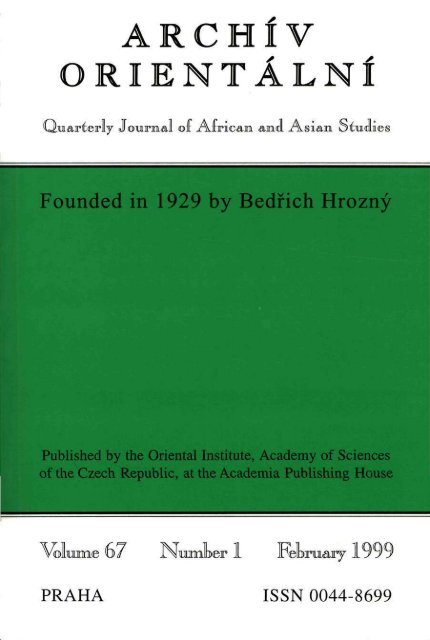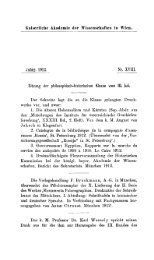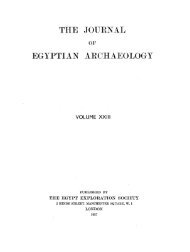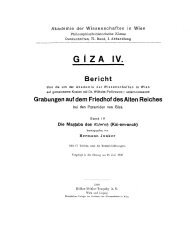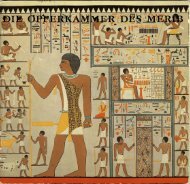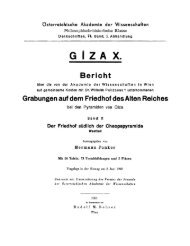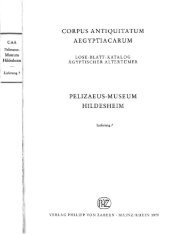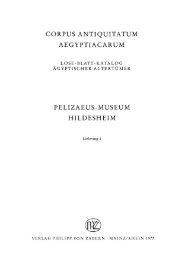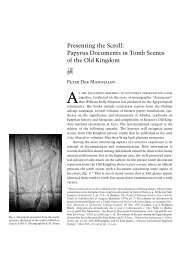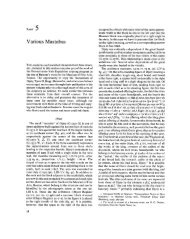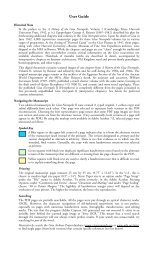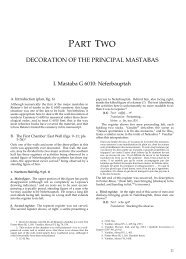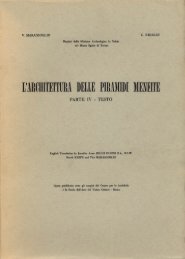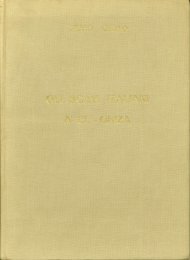ARCHIV ORIENTALNI - Giza Archives Project
ARCHIV ORIENTALNI - Giza Archives Project
ARCHIV ORIENTALNI - Giza Archives Project
Create successful ePaper yourself
Turn your PDF publications into a flip-book with our unique Google optimized e-Paper software.
<strong>ARCHIV</strong><br />
<strong>ORIENTALNI</strong><br />
Quarterly Journal of African and. Asian Studies<br />
Founded in 1929 by Bedrich Hrozny<br />
Published by the Oriental Institute, Academy of Sciences<br />
of the Czech Republic, at the Academia Publishing House<br />
Voluittie o7 INiiLoiltaer 1 February<br />
PRAHA ISSN 0044-8699
<strong>ARCHIV</strong><br />
<strong>ORIENTALNI</strong><br />
Quarterly Journal of African and Asian Studies<br />
Founded in 1929 by Bedrich Hrozny<br />
Published by the Oriental Institute, Academy of Sciences<br />
of the Czech Republic, at the Academia Publishing House<br />
Volume 67 1999<br />
PRAHA ISSN 0044-8699
<strong>ARCHIV</strong> 0R1ENTALNI 67 (1999), No. 1<br />
Contents<br />
Miroslav Bdrta, The Title Inspektor of the Palace<br />
during the Egyptian Old Kingdom 1-20<br />
Mansour el-Noubi, The Portico of the Temple of Ramesses II at<br />
(A Description and Analysis of its Inscriptions) 21-44<br />
Attallah El-Kholy, Quelques remarques sur le Ra-setaou 45-50<br />
LukdS Pecha, Das Amt des sassukkum in der altbabylonischen Zeit 51-71<br />
Matthew W. Waters, ABL 268 and Tammaritu 72-74<br />
Dagmar Markovd, Love Marriage and Arranged Marriage in India 75-82<br />
Mariola Offredi, The Hindi Poet Vinod Kumar Sukl 83-94<br />
Wolfgang Ommerborn, Atheismus im Neo-Konfuzianismus als Weiterfiihrung<br />
der konfuzianischen Tradition der Skepsis und Kritik gegentlber<br />
dem Glauben an Gotter und Geister 95-126<br />
BOOK REVIEWS AND NOTES<br />
H. Waetzoldt - H. Hauptmann (eds.), Assyrien im Wandel<br />
der Zeiten. (Jana Pecirkovd) 127-128<br />
E. Frahm, Einleitung in die Sanherib-Inschriften (Jana Pecirkovd) 128-129<br />
Roland Tefnin (ed.), La Peinture 6gyptienne ancienne.<br />
Un monde de signes a preserver. (Barbora Krumphanzlovd) 129-132<br />
Maged Negm, The Tomb of Simut called Kyky. (Bretislav Vachald) 132-133<br />
Wspaniafy Swiat Oceanu Indyjskiego Sulajmana Kupca, Abu Zajda<br />
as-STraflego i Buzurga Ibn Sahrijara. Od literatury faktu do<br />
przygody i fantastyky (IX-X w.) (Jaroslav Oliverius) 133-134<br />
Alev Tekinay, Gunaydin, Teil 3.: Tilrkische Texte. (Petra Sedmikovd) 134-135<br />
Apollon Davidson - Irina Filatova, The Russians<br />
and the Anglo-Boer War 1899-1902. (Otakar Hulec) 135-136<br />
Katesa Schlosser (ed.), Zulu Mythology as written and illustrated<br />
by the Zulu Prophet Laduma Madela. (Otakar Hulec) 136-137<br />
Jon Kowallis, The Lyrical Lu Xun: A Study of His Classical-Style<br />
Verse. (Olga Lomovd) 137-139<br />
Francoise Bottero, S^mantisme et classification dans 1'^criture chinoise.<br />
Les systemes de classement des caracteres par c!6s du Shuowenjiezi<br />
au Kangxi zidian. (Lucie Olivovd) 139-140<br />
Chen Pingyuan, Ershi shiji Zhongguo xiaoshuo shi, 1897-1916. (Jana Horskd) 140-142<br />
Jing-shen Tao, Two Sons of Heaven. Studies in Sung-Liao<br />
Relations. (Jakub Hruby) 143-145<br />
[Helmut Eimer (ed.)], The Brief Catalogues to the Narthang<br />
and the Lhasa Kanjurs. (J. K.) 145-146<br />
BOOKS RECEIVED 147-148
ARCHfV ORIENTALNf 67 (1999)<br />
The Title Inspector of the Palace<br />
during the Egyptian Old Kingdom*<br />
Miroslav Bdrta, Praha<br />
The present article is concerned with the title hrp c h, Inspector of the Palace,<br />
and its holders during the Old Kingdom. 1 The title belongs among those that<br />
were incorporated quite frequently into the titularies of officials related in some<br />
way to the king or his court in the Early Dynastic and the Old Kingdom periods.<br />
Its earliest attestations date from the Early Dynastic period, 2 but most of its<br />
holders lived during the Fourth and Fifth Dynasties. The title enjoyed the greatest<br />
popularity during the Fifth Dynasty.<br />
Burial stelae of several officials bearing this title date from the Early Dynastic<br />
period. They are known from Abydos (Setka - the reign of Djer, Jp - the reign<br />
of Den, Apermaa - the reign of Merneit, ... nuka - the reign of Semerkhet),<br />
Sabef and Djeserka - the reign of Qaa, and Merka from Saqqara (the reign of<br />
Qaa) [see Figs. 1-2]. It is interesting to note that nearly all of them originated<br />
from Abydos and date exclusively from the First Dynasty. The official Merka<br />
is the only known holder of this title from Saqqara. This is probably due to<br />
the fact that the Abydos cemetery still preserved its prestigious position<br />
during this period (this is indicated, above all, by the royal tombs at Umm<br />
* The abbreviations used throughout the footnotes conform to the rules of Lexikon der<br />
Agyptologie (eds. W. Helck, E. Otto, W. Westendorf, Wiesbaden 1975-1992). This article<br />
was written with support of the Czech Academy of Sciences Grant Agency, Postdoctoral<br />
Grant No. 404/98/PO87. I am indebted to Ph.D. J. Malek and J. Jakeman for correcting<br />
the English of my article.<br />
1 Helck, "Palastverwaltung", LA IV, pp. 647-650. For the term c h as a palace of the king, his<br />
residence, see the discussion by E. Martin-Pardey, "Das 'Haus des KOnigs' pr-nswf\ in:<br />
D. Kessler, R. Schulz, eds., Gedenkschrift fur Winfried Barta, Mainz am Rhein 1995, p. 269.<br />
2 Kaplony, IAF I, p. 365; A. J. Spencer, Catalogue of Egyptian Antiquities in the British Museum<br />
V. Early Dynastic Objects, London 1980, No. 11, p. 16, PI. 6; stele of Setka: Petrie,<br />
Royal Tombs I, Pis. XXXI, Nr. 8 (Z 8) and XXXIV; stele of Ip: Petrie, Royal Tombs I, PI.<br />
XXXI, Nr. 23 (T) and XXXIV; Apermaa: Petrie, Royal Tombs I, PI. XXXI, Nr. 18 (Y); stele<br />
of... nuka: Petrie, Royal Tombs I, PI. XXXI, Nr. 29 (U) and XXXV and Djeserka: Kaplony,<br />
IAF III, Taf. 89, Abb. 336. In addition, there is also a stele of Sabef dated to the reign of<br />
Qaa and showing that he was hrp official in charge of two kings' palaces, see Petrie, Royal<br />
Tombs I, PI. XXX; Vandier, Manuel I, 2, p. 732; 733, Fig. 489. For the person of Sabef see<br />
Helck, Thinitenzeit, pp. 228-229 and recently also G. Dreyer et al., "Umm el-Qaab.<br />
Nachunter-suchungen im friihzeitlichen KOnigsfriedhof. 778. Vorbericht", MDAIK 52, 1996,<br />
pp. 75-76; 76, Abb. 28 and Taf. 15. For the stele of Merka from Saqqara tomb 3505 dated<br />
to the reign of Qaa see Emery, Great Tombs III, Pis. 23b and 39.
2 • Miroslav Barta<br />
el-Qaab). 3 Another interesting feature is the parallel occurrence of this title at<br />
Abydos and Saqqara during the reign of Qaa (Sabef and Djeserka at Abydos,<br />
and Merka at Saqqara).<br />
Following the period of the Second and Third Dynasties from which there are<br />
no known instances of the title, it reappears at the beginning of the Fourth<br />
Dynasty. Its Old Kingdom holders are known from the pyramid cemeteries at<br />
<strong>Giza</strong>, Saqqara, Dahshur and Abu Roash. As this title has not been discussed in<br />
detail before, I shall give a list of its holders first and then discuss its particular<br />
features. I will show that the titles and their diachronic distribution convey<br />
major differences between the Fourth and Fifth Dynasty officials in terms of<br />
their rank and position in society.<br />
10<br />
30cm<br />
Fig. 1: Burial stelae of Setka (la) and Ip (lb) from Abydos [after Petrie, Royal Tombs I,<br />
Pis. XXXI, Nr. 8 - stele of Setka; Petrie, Royal Tombs, PI. XXXI, Nr. 23 - stele of Ip].<br />
3 B. Kemp, "Abydos and the Royal Tombs of the First Dynasty", JEA 52, 1966, pp. 13-22; B.<br />
Kemp, "The Egyptian 1st Dynasty royal cemetery", Antiquity 41, 1967, pp. 22-32; recently<br />
also: Di. Arnold, Lexikon der agyptischen Baukunst, Zurich 1994, pp. 12-13 and Di. Arnold,<br />
"Royal Cult Complexes of the Old and Middle Kingdoms", in: B. E. Shafer, ed., Temples of<br />
Ancient Egypt, London, New York 1997, pp. 32-40.
The Title Inspector of the Palace during the Egyptian Old Kingdom • 3<br />
0 10 30cm<br />
Fig. 2: Burial stele of Sabef from Abydos [after Petrie, Royal Tombs I, PI. XXX].<br />
Catalogue<br />
This catalogue lists forty-five holders of the title hrp c h in chronological order.<br />
It might be useful to remember them [for their titles see Table I]:<br />
The Fourth Dynasty<br />
- Akhtihotep<br />
<strong>Giza</strong>, G 7650, Khufu - Khephren; 4<br />
- Kanefer<br />
presumably from <strong>Giza</strong>, Khufu - Radjedef; 5<br />
-KhufukhafI<br />
<strong>Giza</strong>, G 7130-40, Khufu - the end of the Fourth Dynasty; 6<br />
4 1<br />
Careddu, Museo Barracco, Tav. 2; PMUX , 1, p. 200.<br />
5<br />
Chr. Ziegler, Les Statues Egyptiennes de VAncien Empire, Paris 1997, E 6854 (A 120),<br />
pp. 100-104.<br />
6<br />
W. K. Simpson, The Mastabas of Kawab, Khafkhufu I and II. [<strong>Giza</strong> Mastabas, 3], Boston<br />
1978, pp. 9-20; Pis. XV-XX. PM III 2 , 1, p. 188.
4 • Miroslav Barta<br />
- Anonymous (perhaps Khnumbaf or Babaf) 7<br />
<strong>Giza</strong>, G 7310-20, Khufu - the end of the Fourth Dynasty; 8<br />
-Babaf (Khnumbaf)<br />
<strong>Giza</strong>, middle to end of the Fourth Dynasty; 9<br />
- Yunmin (Fig. 3)<br />
<strong>Giza</strong>, the end of the Fourth Dynasty; 10<br />
- Yunre<br />
<strong>Giza</strong>, the end of the Fourth Dynasty;"<br />
- Sekhemkare<br />
<strong>Giza</strong>, LG 89, Khephren to the early Fifth Dynasty; 12<br />
because of his high ranking titles he is probably approximately contemporary<br />
with the preceding three persons;<br />
- Kaemsekhem<br />
<strong>Giza</strong>, G 7660, the late Fourth Dynasty; 13<br />
- Seshathotep [I. ]<br />
<strong>Giza</strong>, G 5150, the late Fourth Dynasty; 14<br />
- Kanefer<br />
Dahshur, Mastaba Nr. 28, the late Fourth Dynasty; 15<br />
Fig. 3: Doorway lintel from the tomb of Yunmin [after Hassan, <strong>Giza</strong> VII, 17, Fig. 10].<br />
7 See W. K. Simpson, "Topographical Notes on <strong>Giza</strong> Mastabas", in: Fs. Edel, pp. 492-493.<br />
8 For the titles see N. Strudwick, The Administration of Egypt in the Old Kingdom, London<br />
1985, pp. 168-169, No. 170 (unpublished).<br />
9 Hassan, <strong>Giza</strong> VII, p. 7; PM HI 2 , 1, p. 239.<br />
10 Hassan, <strong>Giza</strong> VII, p. 13; PM IIP, 1, p. 237.<br />
11 Hassan, <strong>Giza</strong> VI. 3, 31; PM III 2 , 1, 243. For dating of lunre into the Fifth Dynasty see now<br />
study by P. Janosi, "Gab es Kronprinzen in der 4. Dynastie? 'Kronprinz' lunre", GM 158,<br />
1997, pp. 15-32.<br />
12 ID II, pp. 41-42; Hassan, <strong>Giza</strong> IV, p. 107, Fig. 54; p. 118, Fig. 63; PM III 2 , 1, p. 233.<br />
13 LD II, p. 32; PM III 2 , 1, pp. 201-220.<br />
14 LD II, p. 23; Junker, <strong>Giza</strong> II, p. 182, Abb. 28; for dating see p. 174; PMWl 1 , 1, p. 149 (early<br />
Fifth Dynasty).<br />
15 De Morgan, Fouilles a Dahchour en 1894-1895, p. 23, Fig. 54 and BM Hierogl. Texts P, PI.<br />
9, Nr. 2 (BM 1345). PM III 2 , 2, p. 893.
The Title Inspector of the Palace during the Egyptian Old Kingdom • 5<br />
- Setkai<br />
Abu Roash, the Louvre (E. 12631, E. 12629), the Fourth Dynasty; 16<br />
- Bakai<br />
Abu Roash, Cairo, the Fourth Dynasty; 17<br />
The Fifth Dynasty<br />
-Debeheni<br />
<strong>Giza</strong>, LG 90, the early Fifth Dynasty; 18<br />
- Kaunesut<br />
<strong>Giza</strong>, the late Fourth or early Fifth Dynasty; 19<br />
- Merib<br />
<strong>Giza</strong>, G 2100, the early Fifth Dynasty; 20<br />
- Kanefer<br />
<strong>Giza</strong>, G 2150, the early Fifth Dynasty; 21<br />
-Tjenty<br />
<strong>Giza</strong>, G 4920 (LG 47), the early Fifth Dynasty or later; 22<br />
- Kaninisut [I. ]<br />
<strong>Giza</strong>, G 2155, the early Fifth Dynasty; 23<br />
- Seshemnefer [I. ]<br />
<strong>Giza</strong>, G4940, the reign of Sahure or Neferirkare; 24<br />
-Nenkhefetka<br />
Saqqara, D 47, the reign of Sahure or later; 25<br />
16 M. ROmer, Zum Problem von Titulatur undHerkunft bei den Agyptischen "Konigssdhnen"<br />
des Alten Reiches, Diss. Berlin 1977, 46; Un siecle de fouilles francaises en Egypte<br />
1880-1980, LeCaire 1981, pp. 50-51, No. 55. PM\\\\\, p. 3.<br />
" ROmer, Titulatur und Herkunft, pp. 47-48; Borchardt, Statuen und Statuetten I, p. 123, Bl.<br />
39. /WIII\1, p. 3.<br />
18 LD II, pp. 35-36; for the earlier dating see /Will 2 , 1, p. 235, time of Menkaure. There are,<br />
however, at least two features which contradict such an early dating and favour his early<br />
Fifth Dynasty origin: 1) the occurrence of the titles of hrp c h and jrj-nfr-hit, which are<br />
otherwise characteristic of the Fifth Dynasty. The title oi jrj-nfr-hit does not occur prior to<br />
the beginning of the Fifth Dynasty and the title of hrp c h is during the Fourth Dynasty<br />
obviously associated with the persons of a high social rank, like jrj-p't, hitj- c and/or tijtj<br />
titj n zib. 2) The offering list on the wall in his chapel is also typical of the lists of the Fifth<br />
Dynasty and does not seem to occur earlier, see Barta, Opferliste, p. 48ff. (Listentyp A). I<br />
tend, therefore, to modify even the dating suggested by Barta (Opferliste, p. 47, suggesting<br />
the late Fourth to early Fifth Dynasty date) and to place the tomb at the very beginning of<br />
the Fifth Dynasty.<br />
19 Hassan, <strong>Giza</strong> II, p. 75; p. 82, Fig. 86; p. 85, Fig. 89. PM III 2 , 1, p. 274.<br />
20 LD II, pp. 19-22; Junker, <strong>Giza</strong> II, p. 132.<br />
21 Reisner, <strong>Giza</strong> Necropolis I, Fig. 257; p. 438, Fig. 258; PM III 2 , 1, p. 77.<br />
22 Reisner, <strong>Giza</strong> Necropolis I, 214; LD II, p. 30; PM III 2 , 1, p. 141.<br />
23 Junker, <strong>Giza</strong> II, 159; PM III 2 , 1, p. 78.<br />
24 LD II, 27 and 29; PM III 2 , 1, p. 142.<br />
25 Mariette, Mastabas, 304-309; /'Mill 2 , 2, pp. 580-581.
6 •<br />
Miroslav Barta<br />
-Nefer<br />
<strong>Giza</strong>, LG 99, the middle Fifth Dynasty or later; 26<br />
- Kaemneferet<br />
<strong>Giza</strong>, the middle Fifth Dynasty or later; 27<br />
-Kai<br />
Saqqara, perhaps the middle of the Fifth Dynasty; 28<br />
-Djadjaemankh<br />
Abusir, reign of Neuserre - the end of the Fifth Dynasty; 29<br />
- Ptahshepses<br />
Abusir, the reign of Neuserre; 30<br />
- Hemakhty<br />
Abusir, son of Ptahshepses, the reign of Neuserre or slightly later; 31<br />
- Kaemrehu<br />
Saqqara, tomb C 25, the middle of the Fifth Dynasty or later; 32<br />
- Setju<br />
<strong>Giza</strong>, G 4710, the Fifth Dynasty; 33<br />
- Rawer<br />
<strong>Giza</strong>, the reign of Neferirkare or later; 34<br />
- Wepemneferet<br />
<strong>Giza</strong>, the middle to late Fifth Dynasty; 35<br />
- Mesa (the father of Khuiwer)<br />
<strong>Giza</strong>, the middle Fifth Dynasty; 36<br />
- Mernefu<br />
Abusir, the reign of Isesi; 37<br />
- Tjenty (for his dating see below)<br />
Saqqara, tomb Bl, the middle of the Fifth Dynasty or later; 38<br />
26 Hassan, <strong>Giza</strong> III, p. 200; PM IIP, 1, p. 258.<br />
27 Hassan, <strong>Giza</strong> II, pp. 104-105; p. 109, Fig. 116; p. 110, Fig. 117; p. Ill, Fig. 118. PM1U 2 ,<br />
1, p. 263.<br />
28 Dia Abou-Ghazi, Catalogue General des Antiquites Egyptiennes du Musee du Caire Nos.<br />
57001-57100. Denkmaler des Alten Reiches III. Altars and Offering Tables, fasc. 2: Nos.<br />
57024-57049, Le Caire 1980, p. 41, CG 57048; Strudwick, Administration, p. 144, No. 137.<br />
29 Martin, CAA Bremen, 1/18-20, block B 934; PM IIP, 1, p. 343; Borchardt, Neuserre,<br />
pp. 120-121; p. 121, Abb. 101.<br />
30 M. Werner, Abusir I. The Mastaba of Ptahshepses. Reliefs 1/1-2, Prague 1986, p. 107, No. 162;<br />
p. 119, No. 183.<br />
31 Verner, Ptahshepses, p. 65, No. 69; p. 76, No. 95.<br />
32 Mariette, Mastabas, p. 161. For the false-door see M. J0rgensen, Egypt I (3000-1550<br />
B. C.) Ny Carlsberg Glyptotek, Copenhagen 1996, pp. 64-65, JEIN 1271. PM IIP, 1, 690<br />
(according to Jorgensen, the reign of Djedkare - Unas).<br />
33 Reisner, <strong>Giza</strong> Necropolis I, p. 521; Pis. 74 b and 75 b. PM IIP, 1, p. 135.<br />
34 Hassan, <strong>Giza</strong> I, pp. 2-3; /Will 2 , 1, p. 265.<br />
35 Hassan, <strong>Giza</strong> II, p. 179; PM IIP, 1, p. 281.<br />
36 Hassan, <strong>Giza</strong> V, p. 289; PM IIP, 1, p. 254.<br />
" Excavation of the Czech Institute of Egyptology at Abusir, Exc. Nos. 2/E/78, 3/E/78.<br />
38 Mariette, Mastabas, pp. 88-89; PM IIP, 1, p. 482. For the dating of Tjenty into the late
The Title Inspector of the Palace during the Egyptian Old Kingdom • 7<br />
-Zaib<br />
<strong>Giza</strong>, G 2092+2093, the reign of Isesi; 39<br />
-Neferkui<br />
<strong>Giza</strong>, G 2098, the reign of Isesi - Unas; 40<br />
- Khuiwer<br />
<strong>Giza</strong>, the end of the Fifth Dynasty; 41<br />
- Rahotep, the end of the Fifth Dynasty [Fig. 4]<br />
Abusir, tomb DD; 42<br />
- Perneb<br />
Saqqara, the end of the Fifth Dynasty; 43<br />
- Niuty<br />
<strong>Giza</strong>, the end of the Fifth Dynasty or later; 44<br />
-Nikauradjedef,<br />
Abu Roash, Tomb F 15, the end of the Fifth Dynasty or later; 45<br />
- Kaemneferet<br />
<strong>Giza</strong>, LG 63, the Fifth or the Sixth Dynasty; 46<br />
- Hetepniptah<br />
<strong>Giza</strong>, G 2430 (LG 25), the late Fifth Dynasty (?); 47<br />
Fourth Dynasty see Baer, Rank and Title, p. 153, Nr. 569; Strudwick, Administration, p. 26;<br />
for the late Fourth - early Fifth Dynasty date see H. G. Fischer, "A Scribe of the Army in a<br />
Saqqara Mastaba of the Early Fifth Dynasty", JNES XVIII, 4, 1959, p. 255. E. Eichler in<br />
his Untersuchungen zum Expeditionswesen des dgyptischen Alten Reiches, GOF IV. 26,<br />
1993, p. 230, Tab. 21, No. 39, prefers a Sixth Dynasty date. For the same dating of Tjenty<br />
into the Sixth Dynasty see P.-M. Chevereau, "Contribution a la prosographie des cadres<br />
militaires de l'Ancien Empire et la Premiere PeYiode Interm6diaire (A - Titres militaires)",<br />
RdE 38, 1987, p. 20, No. 52. For the position of his tomb see W. S. Smith, "Topography of<br />
the Old Kingdom Cemetery at Saqqarah", in: Reisner, Tomb Development, Appendix C,<br />
p. 404, No. 71 (Bl) and PM III 2 , 2, PI. XLVI. For the latest discussion of the person of<br />
Tjenty and its date see Ziegler, Les Statues, Nr. 41 (statue of Tchenti, E 10776), pp. 148-151,<br />
early Fourth Dynasty, reign of Khufu - Radjedef.<br />
39 A. M. Roth, A Cemetery of Palace Attendants Including G 2084-2099, G 2230+2231, and<br />
G 2240 [<strong>Giza</strong> Mastabas, 6], Pis. 67a-b, 68c, 69a-b, 69c-d, Figs. 170, 171, 173a, 175a-b,<br />
176a-b. PM III 2 , 1, p. 70, dated to the Sixth Dynasty.<br />
40 A. M. Roth, Cemetery of Palace Attendants, Pis. 105a, 109, Figs. 192, 196. PM\\\ 2 ,\, p. 70<br />
- not included.<br />
41 Hassan, <strong>Giza</strong> V, p. 240, Fig. 100; /Will 2 , 1, p. 254.<br />
42 M. Barta, Tombs of the Middle- and Lower-Rank Officials at Abusir South, Ph. D. Dissertation,<br />
Charles University, Prague 1997, pp. 161-175 and Fig. 4. 2.<br />
43 PM III 2 , 1, p. 497; Williams, Perneb, PI. VI; Hayes, Scepter 1, p. 92, Fig. 51; p. 95, Fig. 53.<br />
44 PA/ IIP, l,p. 133.<br />
45 Bisson de la Roque, Abu Roash 1922-1923, p. 29, Fig. 16; PI. XI. PM III 2 , 1, p. 5.<br />
46 ID II, p. 91, b-c; PM III 2 , 1, p. 208.<br />
47 LD II, pp. 71-72; PM III 2 , 1, p. 94 dates this tomb into the Sixth Dynasty; nevertheless, the<br />
"Speisetischszene" in LD II, p. 71b indicates its late Fifth Dynasty date. Besides this, the<br />
co-occurence of the jrj-jht-njswt and hntj-s 1 titles equally supports the dating of the tomb<br />
into the latter half of the Fifth Dynasty - see Barta, Middle- and Lower-Rank Officials,<br />
Excursus D, pp. 295-314.
8 •<br />
Miroslav Barta<br />
0 10 50<br />
cm<br />
Fig. 4: False-door of Rahotep at Abusir<br />
[Archive of the Czech Institute of Egyptology in Prague].
The Title Inspector of the Palace during the Egyptian Old Kingdom • 9<br />
The Sixth Dynasty:<br />
-Merefnebef<br />
Saqqara, the early Sixth Dynasty (the list of his titles in Table I is incomplete); 48<br />
Uncertain:<br />
-Nikaankh(CG 136)<br />
Old Kingdom. 49<br />
The chronological distribution of the holders of the title hrp c fr shows its<br />
increasing frequency during the Fourth Dynasty (13 out of 45), with the majority<br />
of its holders dated from the Fifth Dynasty (30). The beginning of the Sixth<br />
Dynasty represents a sharp break in comparison with the previous period and is<br />
marked by the title's sudden disappearance (only 1 attestation). During the<br />
Fourth Dynasty ten holders of this title were buried at <strong>Giza</strong>, two at Abu Roash<br />
and only one in Dahshur. None of them, though, was buried at Saqqara, and<br />
this is quite in accordance with the Fourth Dynasty policy which largely<br />
neglected this cemetery.<br />
Surprisingly, this tendency remained virtually the same during the Fifth Dynasty<br />
although the loss of prestige of the <strong>Giza</strong> cemetery was evident. During this time,<br />
the majority of the Inspectors of the Palace continued to be buried at <strong>Giza</strong> (19).<br />
A considerably smaller number of them was buried at Abusir (3 plus the possible<br />
tomb of Hemakhty which has not yet been found 50 ), Saqqara (4) and Abu<br />
Roash (1). One would expect that the majority of these Fifth Dynasty officials<br />
would have preferred to be buried near the centre of government which was, at<br />
this time, undoubtedly in the close vicinity of the Saqqara-Abusir pyramid field.<br />
This is in marked contrast to the officials holding the rank of vizier. Their<br />
example helps to explain the relationship between the burial place of the king<br />
and those of the highest officials. The spatial distribution of the tombs<br />
demonstrates that, unlike the Inspectors of the Palace and some others, 51 the<br />
viziers were buried in the vicinity of their kings. 52 This feature suggests a very<br />
close relationship between the burial place of the king and that of the vizier.<br />
48 K. Mysliwiec, Nowe oblicza Sakkary. Rewelacyjne odkryciapolskich archeologow w Egipcie,<br />
Tuchowie 1998, pp. 11-15; Pis. 14-58.<br />
49 Borchardt, Statuen I, p. 101, PMlll 2 , 2, p. 723.<br />
50 Also the position of his tomb at Saqqara must be taken into account, see tomb H 14, Mariette,<br />
Mastabas, p. 457^althqygh the attested titles and palaeoegraphy of the name of these two<br />
persons differ: ^n or e
10 • Miroslav Barta<br />
Tltlaa/Oflclals<br />
i<br />
o<br />
•H<br />
Kanefer (<strong>Giza</strong>)<br />
i i I !" I<br />
0<br />
i<br />
! !<br />
*<br />
f !<br />
I<br />
•H<br />
a !<br />
jmj-jz o o o o<br />
jmj-r kit nb njswt o o o X<br />
•p<br />
3<br />
M<br />
0<br />
I<br />
I Kaninisut<br />
i y 1<br />
jmj-r wpwt O ° X<br />
jrj-jbt-njswt o X X<br />
jrj-nfr-tiit X X<br />
jrj-p't<br />
r<br />
4-mrDp<br />
r<br />
4-mr n zib<br />
o o o o o o<br />
o<br />
o o o o<br />
o<br />
X<br />
X<br />
X<br />
'4-mr Dwi fir (pit) pt X X<br />
r<br />
4-mr wff<br />
X<br />
w'wrwftb o o o X<br />
wr md Sm r w o o X X<br />
wrmF'Jwnw o o X<br />
wtjnpw o o X<br />
mdw rjfjt o o<br />
rPnb o o X X<br />
hit}-' o o o o o<br />
hm-ntr Biltt o o o<br />
hkiBit X X<br />
hm-ntr fir &th o<br />
hm-npr ffwfw o X X<br />
hrj-wdb m hwt- r nh O o o X X X X<br />
hrj-siti n njswt (m jswtf nbt)<br />
hrj-slti n njswt m fmw<br />
X<br />
hrj-sitHnjtf) o o o X<br />
hrj-sSti n pr-dwlt<br />
hrj-sSti n mdw nphrj-sSti<br />
n nbf<br />
(irj-stti n npf<br />
O o o o o X X X X<br />
hrj-slti Itiw pr-'i<br />
hrj-tp N\)b<br />
hrj-tp njswt<br />
o<br />
o<br />
o X X<br />
X<br />
htmw wji npr<br />
Iftmw bjtj<br />
brj-hb<br />
o o o<br />
o<br />
o<br />
o o<br />
X<br />
X X<br />
hrj-tibnjtf<br />
brj-hb hrj-tp in jtf) o o o<br />
o<br />
X<br />
zi njswt o o o o X X<br />
zi njswt n btf<br />
zi njswt n Ittfsmsw<br />
o o<br />
o o o<br />
o o o<br />
o o o<br />
X X<br />
snv<br />
smr w<br />
o o o o X X X X X X<br />
r tj<br />
smrw<br />
O o o o o o o o X X X X X X<br />
r tj njtf<br />
smr w<br />
o o o o<br />
r tj n mrwt<br />
tijtj {itj n zib o o o o o o<br />
Table I: A list of the most frequent titles attested in combination with the title<br />
°<br />
I.<br />
! i<br />
u<br />
1
The Title Inspector of the Palace during the Egyptian Old Kingdom • 11<br />
Titlas/Oflcials<br />
V<br />
5<br />
a f<br />
•<br />
•p<br />
i i 1 5<br />
3 u<br />
•n *<br />
1)<br />
*)<br />
•n<br />
0<br />
a 1 * 1 s<br />
Imj-jz 1 1 I<br />
3 1 I •n<br />
H ! I X<br />
jmj-r kit nb njswt X X<br />
jmj-r wpwt X<br />
jrj-jbt-njswt X X X<br />
jrj-nfr-hit X X X X c<br />
jrj-pU<br />
r<br />
d-mr Dp X X<br />
c<br />
r<br />
d-mr n zib X X X<br />
r<br />
4-mr Dwi Hr hntj pt<br />
r r<br />
d-mr wh<br />
X<br />
X<br />
X X X X X c<br />
w r wrw hb X X<br />
wr md Sm r w<br />
wrmFJwnw<br />
wtJnpw<br />
X<br />
mdw rhjt<br />
rPnb<br />
X<br />
bit)-'<br />
fm-ntrBiitt<br />
X X c<br />
MBit X<br />
bm-nfr fir Sth X<br />
hm-ntr tfwfw X<br />
hrj-wdb m hwt- r nh. X X X " X X X X X X X X<br />
hrj-sSti n njswt (mjswtfnbt) X X c<br />
hrj-sSti n njswt m bnw X<br />
hrj-iSti(njtf) X X X<br />
hrj-iSti n pr-dwit X X X X X X X X X X X X c<br />
hrj-sSti n mdw n(r X X X X c<br />
hrj-sSti n nbf X X<br />
hrj-sSti n n{rf X<br />
drj-sSti ttiw pr- r i X<br />
(irj-tp Nfrb X X X X X X X c<br />
hrj-tp njswt X<br />
Iftmw wji ntr<br />
tftmw bjtj<br />
X<br />
hrj-hb<br />
hrj-hbnjtf<br />
X X X X c<br />
brj-bbbrj-tp(njtf) X<br />
zi njswt<br />
zi njswt n htf<br />
zi njswt n htfsmsw<br />
X<br />
smr<br />
smr w<br />
X X X X c<br />
r tj<br />
smrw<br />
X X X X X X X X X X X X c<br />
r tj njtf X<br />
smr w r tj n mrwt X X X X X X<br />
tijtj (itj n zib X<br />
_ _ _ _ c<br />
Ptahahaepaaa<br />
Inspector of the Palace (o - the Fourth, x - the Fifth and c - the Sixth Dynasty).<br />
Kaaanafarat<br />
Hatapniptah<br />
1
12 • Miroslav Barta<br />
There are 69 viziers known from the Old Kingdom buried in pyramid fields. 53<br />
With exception of one vizier of the early Fourth Dynasty at Meidum (Nefermaat)<br />
and another at Dahshur (Kanefer), most of them were buried at <strong>Giza</strong> (12) during<br />
the Fourth Dynasty.<br />
The Saqqara-Abusir cemeteries reached the peak of their importance in the<br />
Fifth Dynasty - altogether thirteen viziers built their tombs there (13 at Saqqara<br />
and 1 at Abusir) whereas only eight viziers were buried at <strong>Giza</strong>. This trend<br />
continued in the Sixth Dynasty when a remarkable number of twenty-three<br />
viziers was buried at Saqqara, one at Abusir, but only four at <strong>Giza</strong>.<br />
The cemeteries close to the residence preserved a high degree of exclusivity<br />
during their main phase of activity. This determined the siting of tombs of lesser<br />
officials of the Fifth Dynasty in a less prominent necropolis at <strong>Giza</strong>, which had<br />
declined from its importance in the Fourth Dynasty. I shall show that Inspectors<br />
of the Palace now belonged to the category of these lesser officials during the<br />
Fifth Dynasty.<br />
A closer look at titles associated with that of the Inspector of the Palace<br />
shows that there was a major difference in rank between its holders during the<br />
Fourth and Fifth Dynasties (see Table I). Most of the Inspectors of the Palace<br />
during the Fourth Dynasty belonged to the elite of society (Babaf, Yunmin,<br />
Yunre, Sekhemkare). They usually hold titles like jri-p c t 54 (Khufukhaf I,<br />
Anonymous, Babaf, Yunmin, Sekhemkare, Seshathotep I, Kanefer, Setkai,<br />
Bakai), hitj- c5S (Anonymous, Babaf, Sekhemkare, Kanefer), tijtj tltj n<br />
zlb 56 (Anonymous, Khufukhaf I, Yunmin, Sekhemkare, Seshathotep I, Kanefer)<br />
and zi njswt n htf smsw (Yunmin, Yunre, Sekhemkare, Kanefer, Setkai and<br />
Bakai). These titles suddenly disappear from the titularies of Inspectors of the<br />
Palace at the outset of the Fifth Dynasty. 57<br />
Beside these high-ranking titles, there are others which were granted<br />
exclusively to the holders of the title Inspector of the Palace during the Fourth<br />
Dynasty. These are c l-Dw3w Si (also held by the vizier Ptahshepses of the Fifth<br />
Dynasty), jmj-jz 59 (connected with the service to the king) and htmw<br />
33 See Strudwick, Administration, pp. 300-301 (Table 28). Tombs of five viziers are unknown.<br />
The figure includes also two only recently discovered tombs of viziers Qar (Czech Inst, of<br />
Egyptology, see V. G. Callender, M. Barta, "A Family of Judges at Abusir South", KMT 7.2,<br />
1996, pp. 32-39; M. Verner, "Excavations at Abusir. Seasons of 1994/95 and 1995/96",<br />
ZAS 124, 1997, pp. 79-83) at Abusir and Merefnebef (Polish mission) at Saqqara both<br />
dated into the Sixth Dynasty (MySliwiec, Nowe oblicza Sakkary and "A New Mastaba,<br />
a New Vizier", Egyptian Archaeology 13, 1998, pp. 37-39).<br />
54 Kaplony, "Iripat", LA III, pp. 178-180.<br />
55 Helck, "Hatia", LA II, p. 1042.<br />
56 Helck, Beamtentitel, pp. 134-142; Strudwick, Administration, pp. 300-335; Martin-Pardey,<br />
"Wesir, Wesirat", LA VI, pp. 1227-1235.<br />
57 For the title of zi njswt n htf smsw see Schmitz, Konigssohn, pp. 65-79; Tab. 1, 334 a-b and<br />
Tab. 3, 336 a-b.<br />
58 Probably a religious title, see Helck, Beamtentitel, p. 37.<br />
59 For the term see Wb I, p. 127.2 - "Rammer o. a. als Verwaltungsausdruck"; p. 127.4 - "Werkstatt";<br />
p. 127.5 - "(Werkstatt) besonders fur die Bereitung von Salben"; p. 127.7 - "Palast<br />
des KOnigs oder Teil desselben". Jmj-jz - Wb I, 127. 1 - "im Amts- und Priester- Titel
The Title Inspector of the Palace during the Egyptian Old Kingdom • 13<br />
bjtj 60 ("treasurer", officials responsible for running and controlling the magazines<br />
of the king's residence). 61 Finally, most of the priestly titles hm-ntr + god's<br />
name occurring in the titularies of Inspectors of the Palace are also limited to<br />
the period of the Fourth Dynasty. Three officials of the Fourth Dynasty<br />
(Khufukhaf I, Anonymous, Seshathotep I and Kanefer) had these titles included<br />
in their titularies. The deities which occur in these titles most frequently are<br />
Horus (in his various forms as Hr mhtj, nb Msn, kmi-^, Seth, Sopdu, Bastet<br />
and Anubis. The most plausible explanation for their occurrence has been offered,<br />
namely that these priestly titles describe the nature of the service to the king, i.<br />
e., the duties of officials who were in charge of keeping the king's regalia,<br />
garments and the like. 62<br />
Although the titles of Akhtihotep do not suggest that he belonged to the<br />
class of top officials of the state, the position of his tomb in the East Field at<br />
<strong>Giza</strong> indicates his high status. 63 Its location in the immediate vicinity of the<br />
tomb of Ankhaf (G 7510, reign of Khafre), Meresankh III (G 7540-7550, reign<br />
of Khufu-Shepseskaf), Kaemsekhem (G 7660, late Fourth Dynasty) and<br />
Duaenhor (G 7550, reign of Khufu-Menkaure) does not, in fact, allow a different<br />
interpretation.<br />
The Fifth Dynasty, by contrast, was substantially different in regard to the<br />
previous period. During the Fifth Dynasty the holders of the title were usually<br />
associated with the offices and titles of lesser importance. Besides the fact that<br />
the most distinguished titles born by the Inspectors of the Palace of the Fourth<br />
Dynasty are completely missing (jrj-p c t, hitj- c , tijtj titj n zib, htmw bjtj), the<br />
titles of the middle and lower ranking officials prevail. Among those most<br />
frequently attested during the Fifth Dynasty are smr and smr w c tj, hrj-hb, hrjhb<br />
hrj-tp, c d-mr Dwi Hr hntj pt, hrj-sSti, hrj-sSti n pr-dwit, hrj-tp Nhb, hrjwdb<br />
m hwt- c nh, jrj-nfr-hit.<br />
By far the largest group represents the variants of the hrj-sSti titles. The only<br />
title for which there is a clear Fourth Dynasty counterpart is hrj-sSti n prdwit.<br />
6 * This title, associated with the "Morning God" Dua, 65 occurs both in<br />
the Fourth and Fifth Dynasty. During the Fourth Dynasty the title assumed the<br />
form of C 3-Dw3, occurred quite sporadically, and was associated exclusively<br />
with persons of the high social rank (princes). 66 During the Fifth Dynasty, the<br />
jmj-jz". This title is during the Fourth Dynasty attested also by vizier Nikaure - LD II, p.<br />
15. See also Strudwick, Administration, p. 311; p. 310, Tab. 30.<br />
60<br />
Attested from the reign of Den onwards - see a cylinder seal of Setka (S 3506) - Kaplony,<br />
lAF 111, Taf. 49, pp. 182-185. For the reading of this title see now H. G. Fischer, "On the<br />
Reading of Some Old Kingdom Titles", in: Egyptian Studies III. Varia Nova, New York<br />
1996, pp. 50-52.<br />
61<br />
Helck, Beamtentitel, p. 92; Helck, Thinitenzeit, pp. 215 and 227.<br />
62<br />
Helck, Beamtentitel, p. 41.<br />
63<br />
PM IIP, 1, Plan XVIII.<br />
64<br />
A. M. Blackman, "The House of the Morning", JEA V, 1918, pp. 148-165.<br />
63<br />
Otto, Dua, LA I, p. 1147; Otto, Duai, LA I, pp. 1147-1148; Otto, Duawer, LA I, p. 1151.<br />
66<br />
Helck, Beamtentitel, p. 37.
14 • Miroslav Barta<br />
title was probably changed to brj-sStl n pr-dwit. 61 This modified variant referred<br />
to the duties executed in the part of the palace where the king's morning toilet<br />
took place. 68 Generally speaking, the hrj-sSti part of these various titles referred<br />
to the duty of the officials to keep the secrets of the palace. 69<br />
The title of hrj-wdb m hwt- c nh was related both to priests with the duty to<br />
recite formulae during the offering ceremonies in the tombs, 70 and to officials<br />
employed at the king's court with responsibility for the feasting of the king. 71 The<br />
same secular nature can be attributed to the title of jrj-nfr-hit that appears<br />
only at the beginning of the Fifth Dynasty. 72 Its holders were, above all, stewards,<br />
hairdressers, and manicurists, executing their offices at court. 73 The same<br />
association is apparent in hrj-tp, "chamberlain", a title connected with food<br />
administration. 74 The title c d-mr Dwi Hr hntjpt responsible for supplies of wine<br />
for the king and his residence can be similarly interpreted. 75 Regarding the role<br />
of Inspectors of the Palace, it seems logical, given the evidence above, that this<br />
title remained functional down to the end of the Fifth Dynasty. If it had an<br />
additional, symbolic meaning, it was on account of the personal service which<br />
its holders performed for the king. 76<br />
The main change seen in state administration during the Fifth Dynasty is its<br />
'individualisation', either intentional or spontaneous. Many prestigious positions<br />
were assumed by officials of non-royal origin (a trend well reflected in the<br />
office of the vizier 77 ). This situation is also seen in titles linked to Inspectors<br />
of the Palace during the Fifth Dynasty (see above). Their large numbers may<br />
have been required to define the precise nature of their duties.<br />
The vizier Ptahshepses was the only exception to this rule during the Fifth<br />
Dynasty. Beside the title hrp c h, he also bore the titles bltj- c and tijtj titj n zlb,<br />
i. e., those that are in this combination otherwise attested only during the Fourth<br />
Dynasty. This results from the exceptional position of Ptahshepses at the royal<br />
court of kingNeuserre which was the result of his marriage to the royal daughter<br />
Khamerernebty. 78<br />
67<br />
For its Fourth and Fifth Dynasty holders see Begelsbacher-Fischer, Gotterwelt, p. 238.<br />
68<br />
K. T. Rydstrflm, "HRY SST3 'in Charge of Secrets'. The 3000-Year Evolution of a Title",<br />
DE2S, 1994, p. 65; N. Beaux, "La douat dans les Textes des Pyramides. Espace et temps de<br />
gestation", BIFAO 94, 1994, p. 5. For the astronomical association of Duat with the easter<br />
"morning" horizont see R. Krauss, Astronomische Konzepte und Jenseitsvorstellungen in<br />
den Pyramidentexten, AgAbh 59, Wiesbaden 1997, pp. 207-234.<br />
69<br />
Helck, "Palastverwaltung", LA IV, p. 649.<br />
70<br />
Junker, Gtza II, p. 65.<br />
71<br />
A. H. Gardiner, "The Mansion of Life and the Master of the King's Largess", JEA XXIV,<br />
83-91, p. 1938; H. Goedicke, "Titles for Titles", in: Sch. Allam, ed., Grund und Boden in<br />
Altagypten, Tubingen 1994, p. 234.<br />
72<br />
Helck, Beamtentitel, p. 42.<br />
73<br />
M. Barta, Middle- and Lower-Rank Officials, p. 164 with quotations.<br />
74<br />
Helck, Beamtentitel, p. 60 and Goedicke, "Titles for Titles", pp. 227-228.<br />
75<br />
Zibelius, Agyptische Siedlungen, pp. 204-206.<br />
76<br />
Helck, Beamtentitel, pp. 32-33; Strudwick, Administration, p. 312.<br />
77<br />
Martin-Pardey, "Wesir, Wesirat", LA VI, p. 1227.<br />
78<br />
M. Verner, Forgotten Pyramids, Lost Pharaohs. Abusir, Praha 1994, pp. 173-192.
The Title Inspector of the Palace during the Egyptian Old Kingdom • 15<br />
Major change in palace administration occurred at the beginning of the Sixth<br />
Dynasty and was heralded by the sudden disappearance of the title Inspector of<br />
the Palace. This was probably connected with important changes which were<br />
about to take place in state administration. These probably had in turn<br />
a considerable impact on officials entrusted and associated with the administration<br />
of the king's palace. 79 Of course, this does not necessarily imply that<br />
the need for an office managing the palace became redundant. I would like to<br />
argue that this function was incorporated among the duties of the Sixth Dynasty<br />
viziers. 80 This is attested in the vizirate from the late Middle or early New Kingdom<br />
and described in the Duties of the Vizier. 81<br />
One has to remember, however, that the residence of the king referred to in<br />
the Duties is pr-njswt. Pr-njswt was not only the royal residence but also the<br />
"administrative aparatus" (including individual offices and administrative units)<br />
as a whole. 82 The apparent terminological difference between the Old Kingdom<br />
term c h and the term pr-njswt in the Duties may have been the result of Early<br />
Dynastic tradition. At that time it was the palace of the king (termed c h) that<br />
was essential for administration of the country 83 and this Early Dynastic policy<br />
may have found its reflection during the Old Kingdom in the form of the title<br />
hrp %<br />
With the steady weakening of the central authority it seems possible that Sixth<br />
Dynasty viziers assumed some of the duties, which had previously been assigned<br />
to lower officials. The change in palace administration could have also been<br />
influenced by the transfer of the Sixth Dynasty residential area close to the<br />
Sixth Dynasty royal graveyard at South Saqqara. Another factor may have<br />
been the increasing influence of the provincial officials in the country's administration.<br />
The dominant role played by the viziers in palace administration would<br />
then be a mere response to this development. 84 The dominance of the vizier's<br />
office during the Sixth Dynasty would thus have been a result of the struggle of<br />
the king to limit and control the increasing independence and power of the<br />
officials.<br />
The first indication of this newly pursued policy are the titles from the tomb<br />
of the vizier Merefnebef recently discovered at Saqqara. His titles show that he<br />
had executed the duty of an Inspector of the Palace before he was promoted to<br />
the office of the vizier. Therefore, his titles represent a "missing link" between<br />
lower ranking Inspectors of the Palace in the Fifth Dynasty and the viziers of<br />
79 Strudwick, Administration, pp. 339-340, reforms of Djedkare.<br />
80 See Strudwick, Administration, pp. 328-332.<br />
81 G. P. F. van den Boorn, The Duties of the Vizier. Civil Administration in the Early New<br />
Kingdom, Studies in Egyptology, London 1988, p. 54 ff. and pp. 310-315.<br />
82 See Martin-Pardey, "Haus des KOnigs", pp. 270-285.<br />
83 Kaplony, IAF I, pp. 364-367; Helck, Palastverwaltung, LA IV, pp. 647-650; Helck,<br />
Thinitenzeit, pp. 212-221 (Die Entstehung der Verwaltung).<br />
84 This trend is noticable already at the end of the Fifth Dynasty, probably during the reign of<br />
Djedkare and during the rule of Teti, see N. Kanawati, Govermental Reforms in Old Kingdom<br />
Egypt, London 1980, pp. 11-28.
16 • Miroslav Barta<br />
the Sixth Dynasty. 85 Some of Merefnebef's titles relate to the preceding period<br />
(jrj-nfr-hit, hrj-wdb m hwt- c nh, hrj-s&ti n pr-dwit) whereas others are identical<br />
with titles held by the Inspectors of the Palace during the Fourth Dynasty period<br />
(jr}-p c t, h3tj- c , tijtj tjtj n zib).<br />
The summary of titles associated with Inspectors of the Palace during the<br />
Fifth Dynasty shows clearly the main aspects of this office: to take care of the<br />
personal service to the king, of his person, dress and crowns, feasting, daily<br />
supplies to his palace and the like. This is a picture similar to that known from<br />
the later composition of the Duties of the Vizier. In this light, therefore, the<br />
hypothesis that the title of Inspector of the Palace was incorporated in the<br />
duties of the viziers already during the Sixth Dynasty seems quite likely. 86 This<br />
was probably a reaction to the Fifth Dynasty policy in administration which<br />
proved inefficient in terms of the state authority and enabled an undesirable<br />
rise in bureaucracy); 87 this in turn instigated profound changes in the vertical<br />
hierarchy of the state apparatus. 88<br />
The very high frequency of these titles during the Fifth Dynasty requires some<br />
explanation. Assuming that the Fifth Dynasty lasted for 158 years, 89 each of<br />
the thirty holders would have stayed in his office for five years on average.<br />
This period may have been even snorter since we cannot be sure there were no<br />
other holders of this title during the Fifth Dynasty. In one case we are informed<br />
that one of the sons of the Abusir vizier Ptahshepses, Hemakhty, was probably<br />
appointed to the office of hrp < h as a young man. 90 This might indicate that the<br />
office was one of the first steps on the way to higher office. It was probably<br />
associated with young officials who, after gaining appropriate experience at<br />
court, were appointed to higher posts. In fact, several sons of the vizier<br />
Ptahshepses started their careers at court 91 :<br />
- most of them bore the title hm-jzt (Kahotep, Ptahshepses Junior I and II,<br />
Hemakhty, Nisuked);<br />
- in addition to this, Ptahshepses Junior II was also appointed jrj-nfr-hit and<br />
Hemakhty hrp c h. 92 All these titles show close affinity of their holders to the<br />
king.<br />
83 Mys"Iiwiec, Nowe oblicza Sakkary, Pis. 27b, 28, 29, 32, 34, 35, 39, 41, 42, 45, 53, 54.<br />
86 D. M. Doxey, Egyptian Non-Royal Epithets in the Middle Kingdom. A Social and Historical<br />
Analysis, Leiden 1998, pp. 177-180, parallels some other early Middle Kingdom vizier titles<br />
with the later Duties of the Vizier. See also W. K. Simpson, "Mentuhotep, Vizier of Sesostris<br />
I, Patron of Art and Architecture", MDAIKM, 1991 (Festschrift fur W. Kaiser), pp. 331-340.<br />
87 Helck, Politische Gegensdtze, 20.<br />
88 R. Muller-Wollermann, "Das Sgyptische Alte Reich als Beispiel einer Weberschen PatrimonialbUrokratie",<br />
BES 9, 1987/88, 33-39<br />
89 J. von Beckerath, Chronologie des pharaonischen Agypten. Die Zeitbestimmung der<br />
dgyptischen Geschichte von der Vorzeit bis 332 v. Chr., MAS 47, Mainz 1997, 155.<br />
90 Verner, Ptahshepses, 65, No. 69; 76, Nos. 94-95.<br />
91 For the general discussion see Verner, Ptahshepses, 43-45, Pis. 24-25, Photos 38-40, Doorway<br />
between Room 3 and 4 - South wall; 92-97.P1. 51, Photos 87-88, Room 10 - East wall;<br />
98-103, PI. 54, Photo 94, Room 10-North wall.<br />
92 Verner, Ptahshepses, 65, No. 69; 76, Nos. 94-95.
The Title Inspector of the Palace during the Egyptian Old Kingdom • 17<br />
Ptahshepses's sons were people of a distinguished origin and high social status,<br />
and they started the trend leading to the reappearance of the high officials at the<br />
king's court by the end of the Fifth Dynasty (i. e., within the following 40-60<br />
years, or so 93 ) and towards an attempt to consolidate (i. e., to centralise) the<br />
administrative affairs of the state. Titularies of the Sixth Dynasty'viziers<br />
including titles that were during the previous period reserved for the lesser<br />
officials (jmj-r jzwj hkrt njswt, jmj-r Snwt,jrj-nfr-hit, hrj-sSti and its variants,<br />
hrj-sSti n pr-dwit, hrp hwwt nt, hrp Sndjt nbt), provide the most reliable evidence<br />
for this.<br />
I suggest, therefore, that the process of gradual loss of central control and<br />
royal authority was already discernible several decades before the end of the<br />
Fifth Dynasty. This assumption can be further supported by an increasing number<br />
of exemption documents from the second half of the Fifth Dynasty onwards.<br />
94 All this shows that these changes started under Neuserre. Moreover,<br />
it was during Neuserre's reign that a new high administrative office was introduced,<br />
95 the jmj-r Sm c w, "Overseer of Upper Egypt". 96 This was one of the steps<br />
preceding the office of the vizier. 97 K. Baer suggested that the introduction of<br />
the title was due to the increasing power of the provincial officials, 98 whereas<br />
E. Martin-Pardey believes that the reason for its introduction was probably a<br />
reform of the tax administration. 99 In any case, it represented one of the major<br />
innovations during the Fifth Dynasty. Also, the reason for its existence can be<br />
seen in an attempt to restore the central authority. The changes which can be<br />
seen in the title Inspector of the Palace make perfect sense within such a<br />
historical framework.<br />
Appendix<br />
Remarks on the date of tomb MM Bl, tomb ofTjenty, at Saqqara<br />
Saqqara tomb B1, ofTjenty, usually dated from the Fourth to Sixth Dynasties,<br />
presents serious dating problems. The following criteria can be used:<br />
1. the position of the tomb in the cemetery and its architectural features,<br />
2. the titles preserved on the false-door,<br />
Beckerath, Chronologie, 188.<br />
Goedicke, Kdnigliche Dokumente, pp. 231-248.<br />
The official Kai is the oldest holder of this title known so far, see Strudwick, Administration,<br />
pp. 142-144.<br />
Kees, Provinzialverwaltung I, 87; Helck, Beamtentitel, p. 109; Goedicke, H., "Zu jmj-ri Urn'<br />
und tp im c im Alten Reich", MIO IV. 1, 1956, p. Iff.; Martin-Pardey, Provinzialverwaltung,<br />
p. 152.<br />
Helck, Beamtentitel, p. 109. Strudwick, Administration, pp. 308-309, Tab. 29. In his table,<br />
Kai and Rashepses are not included so that Strudwick's number of Overseers of Upper<br />
Egypt who became viziers amounts to nine only.<br />
Baer, Rank and Title, p. 301.<br />
Martin-Pardey, Provinzialverwaltung, p. 55.
18 • Miroslav Barta<br />
3. the scene of a funerary repast and its iconography and,<br />
4. the statue of Tjenty kept in the Louvre.<br />
ad 1.:<br />
The position of the tomb of Tjenty within a clearly delineated cluster of tombs<br />
to the north of the Djoser's Step Pyramid complex favours the hypothesis that<br />
these tombs could be roughly contemporary. The following tombs are in its<br />
close vicinity:<br />
- C 18 (72) of Tjenty, the middle Fifth Dynasty or later; 100<br />
- D 13 (73) of Shepsy, probably the early Fifth Dynasty; 101<br />
- D 12 (74) of Niankhsakhmet, the reign of Sahure; 102<br />
- D 10 (75) of Tepemankh I, the end of the Fifth Dynasty or the Sixth Dynasty; 103<br />
- D 11 (76) of Tepemankh II, the middle of the Fifth Dynasty; 104<br />
- D 9 (77) of Meruka, the Fifth Dynasty; 105<br />
- D 70 (LS 15) of Pehenuika, the middle of the Fifth Dynasty or later. 106<br />
Therefore, the location of Tjenty's tomb at Saqqara exclusively among those<br />
of the Fifth Dynasty suggests that they are of the same date, most likely the<br />
latter half of the Fifth Dynasty. Moreover, virtually no tombs of the Fourth<br />
Dynasty are known at Saqqara. The great majority of the Fourth Dynasty officials<br />
were buried at <strong>Giza</strong> whereas Saqqara burial ground fell into disuse and<br />
become once again popular only at the beginning of the Fifth Dynasty.<br />
The true cruciform chapel of the tomb, with a serdab situated to the south of<br />
it, shows strong affinities with early Fourth Dynasty tombs at Saqqara and<br />
Meidum when this layout was at stake. Nevertheless, a short revival of this<br />
layout also occurred in <strong>Giza</strong> tombs during the Fifth Dynasty. 107<br />
ad 2.:<br />
The titles of Tjenty are as follows: jrj-jht-njswt, w c b Nmtj, hrp c h, jmj-r c h,<br />
hm-ntr Hwfw, hm-ntr Hnm hntj Hr-wr m jswtf nbt, nfr jdw, jmj-r mS c , jmj-r<br />
wpwt, htmw ntr, hrp c prw nfrw. The title of the priest of Khufu represents the<br />
100 PM III 2 , 2, p. 482. Now also M. Baud, "Aux Pieds de Djoser. Les mastabas entre fossd et<br />
enceinte de la partie nord du complexe fune>aire", in: C. Berger, B. Mathieu, eds., Etudes<br />
sur I 'Ancien Empire et la necropole de Saqqara dediees a Jean-Philippe Lauer, OrMonsp<br />
IX, Montpellier 1997, p. 75.<br />
101 /Will 2 , 2, 482. Baud, OrMonsp. IX, p. 75.<br />
102 PMIU 2 , 2, 482. Baud, OrMonsp. IX, p. 76.<br />
103 PM III 2 , 2, 483. Baud, OrMonsp. IX, p. 76.<br />
104 PM III 2 , 2, 483. Baud, OrMonsp. IX, p. 76.<br />
105 PM III 2 , 2, 484. Baud, OrMonsp. IX, p. 76.<br />
106 PM III 2 , 2, 491. Baud, OrMonsp. IX, p. 75.<br />
107 See Y. Harpur, Decoration in Egyptian Tombs of the Old Kingdom. Studies in Orientation<br />
and Scene Content, London 1987, 315, Tab. 5. 1.
The Title Inspector of the Palace during the Egyptian Old Kingdom • 19<br />
ante quern non limit for its dating. 108 The considerable number of Tjenty's titles<br />
also favours a date in the latter half of the Fifth Dynasty. 109 Moreover, the<br />
Fourth Dynasty holders of the military title of Overseer of the Army were of a<br />
very high rank. 110 This does not, however, apply to Tjenty. His military titles<br />
(jmj-r m$ c , lu htmw ntr, 112 hrp c prw nfrw m ) indicate that Tjenty was also<br />
concerned with the leadership of royal expeditions. 114 The title of Overseer of<br />
Orders {jmj-r wpwt) seems to have been connected with high state offices during<br />
the Fourth Dynasty. 115 Chronological distribution of all these titles suggests a<br />
Fifth Dynasty date. Also the known attestations of the god Nemty (read also<br />
Anty) are dated exclusively to the Fifth or Sixth Dynasties. 116<br />
ad 3.:<br />
The height of the loaves placed on the offering table reaches the owner's<br />
shoulders and is therefore to be classified as a stage c in their development,<br />
dated by N. Cherpion to the Fifth Dynasty down to the reign of Unas." 7<br />
The motif of the tomb owner and his wife seated at opposite sides of an<br />
offering table seems to belong to the Fifth Dynasty, with no clear precursors<br />
in the Fourth Dynasty." 8<br />
Relatively earlier is the offering formula on the false-door containing<br />
W. Barta's "Bitte 2". It occurs in Egyptian tombs from the Fourth Dynasty<br />
onwards." 9 However, the "Speisetischszene" on the false-door, with the offer-<br />
108<br />
For dating of Tjenty into the reign of Khufu see N. Cherpion, Mastabas et Hypogees<br />
d'Ancien Empire. Le Probleme de la dotation, Bruxelles 1989, p. 225 (Index I A) and<br />
Ziegler, Statues, pp. 150-151 (Khufu-Radjedef).<br />
109<br />
The same opinion was expressed by Baer, Rank and Title, pp. 295 and 240, Tab. I who<br />
despite dating of Tjenty into the mid Fourth Dynasty or later (p. 154, No. 569) suggests<br />
that his titles conform to the second half of the Fifth Dynasty.<br />
110<br />
Eichler, Expeditionswesen, p. 231.<br />
111<br />
Eichler, Expeditionswesen, Tab. 21, pp. 224-230; Cheverau, RdE 38, 1987, pp. 14-21.<br />
1,2<br />
Eichler, Expeditionswesen, Tab. 24, pp. 243-250; P.-M. .Cheverau, Contribution a la<br />
prosographie des cadres militaires de I'Ancien Empire et de la premiere Periode<br />
Intermediate (B - Titres nautiques), RdE 40, 1989, pp. 3-11.<br />
113<br />
Cheverau, RdE 40, 1989, pp. 24-28.<br />
114<br />
Helck, Beamtentitel, p. 101. Already Helck made the observation that Tjenty represents an<br />
exceptional case within the Fourth Dynasty title holders context, see Beamtentitel, p. 95.<br />
For the title ofnfrjdw see H. G. Fischer, "The Inspector of Youths NFR-N-HWFW", OMRO<br />
41, 1960, pp. 1-13.<br />
115<br />
M. Valloggia, Recherche sur les „Messagers" (WPWTYW) dans les sources Egyptiennes<br />
Profanes, Geneve 1976, 29-31; see also E. Martin-Pardey, "Gedanken zum Titel KH", SAK<br />
11, 1984 (Fs Wolfgang Helck), p. 234.<br />
116<br />
Begelsbacher-Fischer, Gotterwelt, p. 221.<br />
117<br />
Cherpion, Mastabas et Hypogees, pp. 47; 46, Fig. 32c; M. Barta, "Archaeology and Iconography:<br />
bdi and c prt bread moulds and „Speisetischszene development in the Old Kingdom",<br />
SAK 22, 1995, p. 25 (Stage iii).<br />
118<br />
Harpur, Tomb Decoration, pp. 79, 5. 3. 8. 8.<br />
119<br />
Barta, Opferformel, p. 9.
20 • Miroslav Barta<br />
ing formula and reduced offering list, is typical of the Fifth and Sixth Dynasties.<br />
120<br />
ad 4.:<br />
The statue of Tjenty displays features which belong to the latter half of the<br />
Fifth Dynasty, too 121 :<br />
- the shoulder length wig resting only slightly on the back of the statue; 122<br />
- the ears only partially exposed under the wig; 123<br />
- the relatively large head, the large wide eyes, the pinched waist and poorly<br />
modelled muscles; 124<br />
- the well modelled knees and clear curve of the shinbone; 125<br />
- the removal of negative space between the body and the limbs. 126<br />
To round up the discussion above, the majority of the criteria used here<br />
support the latter half of the Fifth Dynasty as the most plausible date of the<br />
tomb of Tjenty.<br />
120 Barta, Opferliste, p. 59.<br />
121 For the complete photographic documentation of the statue see Ziegler, Statues, pp. 148<br />
(frontal view), 149 (side views), 150 (back view) and 151 (details).<br />
122 N. Cherpion, "La statuaire privee d'Ancien Empire: indices de datation", in: N. Grimal,<br />
(ed.), Les criteres de dataion stylistiques a I'Ancien Empire, Le Caire 1998, p. 104.<br />
123 Cherpion, La statuaire, p. 105.<br />
124 E. Rusmann, Egyptian Sculpture. Cairo and Luxor, Cairo 1989, p. 45; E. Russmann,<br />
"A Second Style in Egyptian Art of the Old Kingdom", MDAIK 51, 1995, pp. 269-270.<br />
125 Compare, for instance, the similar shinbone line on the contemporaneous statue of<br />
Djadjaemankh from <strong>Giza</strong>, A. Eggebrecht, ed., Pelizaeus-Museum Hildesheim. Die dgyptische<br />
Sammlung, Mainz 1993, p. 29, Abb. 21.<br />
126 Russmann, Second Style, p. 272.
Archiv orientdlni<br />
Quarterly Journal of African and Asian Studies<br />
contains articles, occasional papers, review articles, book reviews and<br />
notes in English, German and French dealing with the history, economy,<br />
culture and society of African and Asian countries in the broad sense.<br />
(For further details of contributions see inside back cover.)<br />
Reviews of books and annotations will appear regularly in each issue of<br />
Archiv orientalni. Authors and publishers of both books and periodicals<br />
concerning African and Asian studies are invited to send free copies of<br />
their works for review purposes.<br />
Lists of contents available on<br />
http://www.lib.cas.cz/knav/journals/eng/Archiv_orientalni.htm<br />
Editorial Office:<br />
ISSN 0044-8699<br />
Pod vodarenskou vezi 4<br />
182 00 Praha8-Liben<br />
Czech Republic<br />
e-mail: aror(3)orient.cas.cz 9 770044"869000<br />
01


